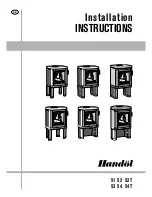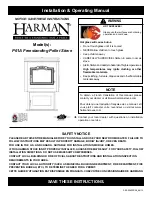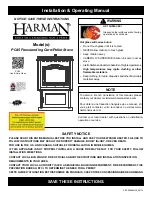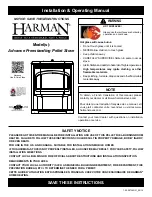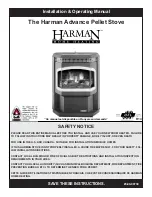
22
GB
INSTRUCTION MANUAL
“Ecofire”
clean combustion STOVE
by
P A L A Z Z E T T I
DOUBLE COMBUSTION SYSTEM
In a wood stove, a correctly burning flame emits the same amount of
carbon dioxide (CO
2
) as would be released through natural decompo-
sition of the actual wood.
The amount of CO
2
produced by the combustion or decomposition of
a plant is the same as the amount of CO
2
that plants are able to draw
from the atmosphere and transform into oxygen during the course of
their life cycle.
Unlike wood, when fossil fuels (coal, diesel oil, gas) are burned, a huge
amount of CO
2
, accumulated over millions of years, is emitted into the
atmosphere, contributing to the “greenhouse effect”. Therefore, using
wood maintains the perfect balance of nature as it is a renewable fuel
compatible with the natural ecological cycle.
The principle of clean combustion followed by Palazzetti in the deve-
lopment of its stoves and fireplaces is fully in line with these objectives.
What do we mean by clean combustion and how does it work? By
controlling the flow of primary and secondary air, a second level of
combustion, or post-combustion, takes place, indicated by a clearer
and stronger flame that develops above the main flame. Introducing
secondary air means unburned gases are consumed, improving ther-
mal efficiency considerably and minimizing the harmful emission of CO
(carbon monoxide) resulting from incomplete combustion. This is an
exclusive feature of our stoves and other PALAZZETTI products.
Natural decomposition or combustion cycle
Fig. 1: COMBUSTION DECOMPOSITION; PERFECT COMBUSTION
C+O
2
=CO
2
+ HEAT
Fig. 2: Post-combustion; CO+1/2O
2
=CO
2
+ heat; CO
Primary combustion
Traditional combustion
PALAZZETTI double combustion system
INSTALLER
1 – ECOFIRE: GENERAL WARNINGS
Dear customer,
Congratulations on your recent purchase of our product. To help you
get the most out of your new ECOFIRE stove, we suggest you follow
the instructions contained in this operating and maintenance booklet
very carefully. Most importantly, make sure that installers, who must
have appropriate technical qualifications, read the specific technical
information so that they are familiar with installation procedures before
starting.
1.1
DESCRIPTION
ECOFIRE is the new, technologically innovative Palazzetti stove which
produces hot air while maintaining a safe, healthy living space, with a
burn time between refuelling of up to 100 hours (mod. Ginevra).
ECOFIRE is easy to operate: just regulate it according to your needs
and fill the bin with wood pellets.
ECOFIRE features sophisticated automatic devices and control sy-
stems making it functional and exploiting its features to the full. The
stove has a double (PRIMARY and SECONDARY) combustion system,
which increases its efficiency and results in the emission of “cleaner
smoke”.
The ECOFIRE stove has been awarded the CE certificate of conformity
for safety and electrical components.
1.2
IDENTIFICATION AND INSPECTION DATA PLATE
The plate can be found inside, on the right-hand side, and features the
Serial Number, which must always be quoted in case of queries.
(Fig. 3)
1.3
DESCRIPTION OF FUEL
•The stove has a wood pellet bin located on the back with a lid that lifts
up for top loading (the insert version has no lid). See the technical
sheets at the end of the booklet for relevant capacities.
GB
• Never obstruct the lid: it must be opened to load the pellets.
• ECOFIRE’s efficiency and heat output may vary depending on the
type and quality of the wood pellets used; the ones we recommend
have these specifications:
• dimensions: Ø 6 - 7 mm, max. length 30 mm
• maximum moisture content: 8-9%
• Wood pellets are a compound made from various types of wood
pressed mechanically in accordance with environmental protection
standards.
• They have a high “net calorific value” (NCV), of approx. 4,160 kcal/
kg, certified by laboratory analysis (C.C.I.A.A. – TS 2498/95).
• ECOFIRE can also be fuelled with wood as long as it is well-seasoned
and of the right size.
N.B.
Common wood, with a moisture content of 10 - 20%, has an NCV
of 2,500 – 3,500 kcal/kg.
GROSS CAL. VALUE OF WOOD
No moisture (kcal/h x kg)
TYPE OF WOOD: POPLAR, OAK, BEECH, FIR-WOOD*, CHESTNUT,
OAK, BIRCH
*The use of conifers (pine, fir-wood) is not recommended: they contain
a high level of resinous substances that quickly clog the flue
Fig. 5: LOADING PELLETS
2 – ECOFIRE: ASSEMBLY INSTRUCTIONS
2.1 – APPLICABLE CLEARANCES
The measurements below indicate the minimum distances combustible
material and objects must be kept from the stove.
2.1.1 SPACE AROUND THE STOVE
(Fig. 7)
Protect any structures liable to catch fire if exposed to excessive heat
from heat radiated by the fire.
Wooden floors or other flooring in flammable materials must be pro-
tected with non-combustible material, such as a 3-4 mm thick metal
sheet, to cover the floor in front of the stove.
Any wooden beams above the ECOFIRE stove must be protected with
fireproof material. (Fig. 8).
A Floor protector in front of the stove 30 - 50 cm
B Side wall clearance
15 cm
C Ceiling clearance
20 cm
2.1.2 ALCOVE DIMENSIONS
(Fig. 9)
The figure illustrates the clearances to be allowed for when installing
the stove in an alcove.
2.2 – ELECTRICAL CONNECTIONS
To connect the stove to the mains, simply plug it into a relevant wall
outlet. (Fig. 10)
WARNING!
Make sure that the system is earthed in accordance with specifications
prescribed by the law, and that it features a circuit-breaker.
Fig. 7: REAR WALL, ADJACENT WALL, SIDE WALL, FLOOR PRO-
TECTOR
2.3 - EXTERNAL AIR INTAKE
PALAZZETTI s.p.a. recommends air for combustion be taken from
outside for the sake of health and hygiene as much as for safety.
Technically speaking, the stove can work with combustion air taken
from the room the stove is in.
The combustion air intake may be ducted outside using a pipe with a
cross-section of at least 50 mm. For distances exceeding 50 cm, by
way of an alternative, make a through-hole in the wall for the air measu-
ring between 80 and 100 mm in diameter, covered with a wall grille,
without connecting it directly to the stove. (Fig. 14)
2.4 – FLUE
The flue must be installed in compliance with standards UNI 9615 -
9731 set by the Italian Institute for Standardization with respect to its
dimensions as well as to the material with which it is manufactured. In
addition, it must conform to the instructions given in the instruction
manual.
Hence, the installer is advised to examine the instructions given in the
manual before starting work.
N.B.
The stove operates with a vacuum combustion chamber, whilst the flue
is under slight pressure. Therefore, you must ensure that the extraction
system is airtight.
Summary of Contents for CLASSIC
Page 51: ......































